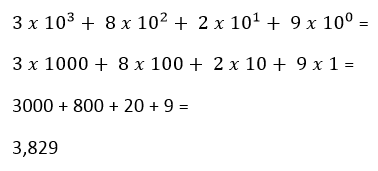#1,077 – The Decimal Numeral System
April 17, 2014 2 Comments
Humans normally represent numeric values using the decimal numeral system. Decimal is a base 10 numeral system, which means that we use ten different digits (numeric symbols) and represent a particular number using a string of these digits. Our ten digits are: 0, 1, 2, 3, 4, 5, 6, 7, 8, and 9.
Moving from right to left, the digits in a base 10 system represent powers of 10 (1, 10, 100, etc. or 10^0, 10^1, 10^2, etc). The value of the number is the sum of the value of each digit multiplied by the appropriate power of 10. For example:
As an example, the number 3829 represents: three thousand (3 x 1000), eight hundred (8 x 100), and twenty (2 x 10) nine (9 x 1).

